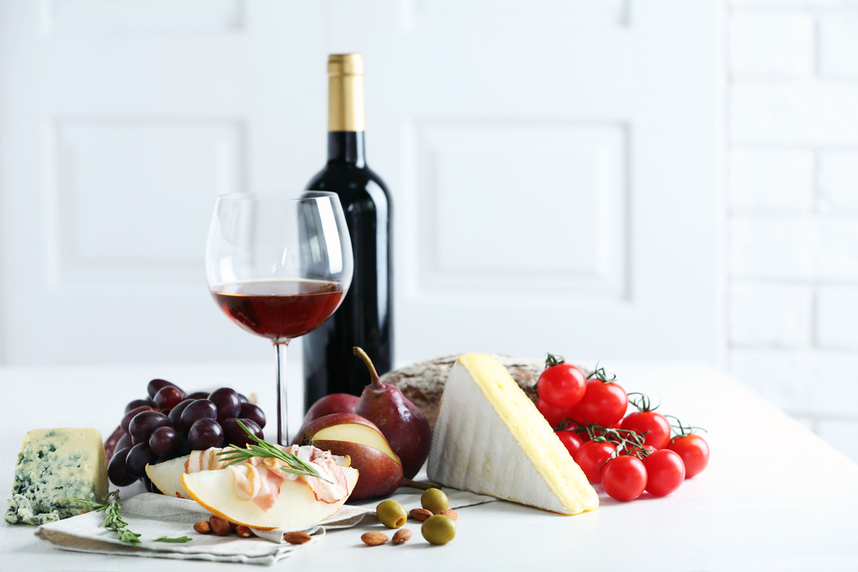At home, some call it Médoc Nir, Picard or Sémillon rouge, but the name by which it is known to most is Merlot. Considered by experts to be so versatile as to be almost a 'simple' wine, it is the child of one of the most famous and important international grape varieties ever. Born in France but spreading in and out of Europe by the end of the last century, Merlot has found a particularly favourable terroir in Italy, which has allowed it to flourish in many regions, with different organoleptic yields depending on the area. Here are the characteristics and best pairings of Italian Merlot!
A French grape variety conquering the world: origins and history of Merlot
Linked to a rather interesting fact is the - alleged - origin of the name 'Merlot'. The French word from which it derives its etymology means 'blackbird', and the association is motivated by the fact that, according to one theory, this species of bird is particularly fond of the grapes of the vine. Another, equally valid, hypothesis states that the reference to the blackbird arose simply because of the bluish black colour of the grapes, reminiscent of this bird's dark plumage.
Whatever the etymological truth, there is no doubt about the origins of the Merlot grape variety, which can be found in the Gironde region of France, in Bordeaux, an area famous for producing many prestigious reds.
Its name first appeared in some records dated 1784, but it is much more likely that it had been known for a long time, at least in its territory of origin, where the vine thrived thanks to the massive presence of forests, a well-ventilated climate and fertile soil consisting mainly of gravel.
Thanks to genetic examinations, another thing that scientists are certain of is Merlot's descent from two other French grape varieties, Cabernet Franc and Magdeleine Noire des Charentes, which over time have crossed naturally, giving rise to new grape varieties. It can therefore be said that pure French blood (or rather wine) flows in the grapes of Merlot, but the strong link with its homeland has not prevented this grape variety from evolving and seeking its fortune elsewhere: in Italy towards the end of the 19th century and in the following century also in many other countries, such as Chile, Argentina, the United States, Australia, South Africa and Switzerland.
The credit for this exploratory and adventurous spirit goes to its softness and marked adaptability, which have allowed it to take root in different territories and to be widely appreciated by those who wish to enjoy a red wine without complexity.
Merlot did not take root indiscriminately in Italy, but initially found favourable terroirs in Trentino-Alto Adige, Veneto and Friuli. It later spread to Tuscany and - with some slightly spicy examples - also to southern Italy.
Merlot wine terroir in Italy and organoleptic characteristics
In order to delve deeper into the characteristics of Merlot wine, it is first of all important to be aware that there is not just one. In addition to its various international declinations, the grape variety has also taken on different traits in Italy, depending on the specific production areas and their climatic and geological conditions.
It is therefore possible to speak of a Merlot that has a medium body, moderate tannins and a fruity, slightly sweetish bouquet (with a more pronounced structure when used in a blend with Cabernet Sauvignon), but this would only be the beginning of a much broader discourse on the facets of this wine, which depend on the characteristics of the main Merlot-producing regions in Italy.
Merlot in Trentino-Alto Adige
The spread of the Merlot grape variety in Trentino-Alto Adige has been facilitated by the particular environmental characteristics of the region, which offers the vines an Alpine climate characterised by discrete temperature fluctuations and a medium-textured soil composed mainly of gravel, limestone and clay. Cultivated above all in the hilly area of the region (on average between 250-300 metres above sea level), both in the province of Trento and in South Tyrol, the vine also ripens thanks to good sun exposure, resulting in a wine with intense notes.
The garnet red colour is only the most obvious of the traits of a Merlot Alto Adige DOC 2020, revealing on the nose notes of red and black fruits, including blackberries, currants, blueberries and cherries, with a hint of elderberry. However, there are also distinctive hints of spices and herbs, almost reminiscent of the region's wilderness. In the mouth, it is structured and soft, with firm tannins and vanilla notes that linger on the finish.
The characteristics of Merlot from Veneto
The Veneto Merlot production area is mainly made up of gentle hills of low altitude, located mainly in the Euganean Hills and Berici Hills area, where the climate is mild and the humidity level is medium. The soils are of medium consistency, characterised by soils of volcanic origin rich in limestone and clay.
All this contributes to the production of a wine with an intense ruby red colour, which on the nose releases an enveloping and heady bouquet of flowers. Notes of violets tickle the nose, along with hints of small red fruits. It is also a revelation on the palate: soft, dry and full, with discreet tannins and a rather persistent finish, as can be perceived in a glass of 'Falconera' Merlot Montello DOC 2020.
Merlot traits in Friuli-Venezia Giulia
The Colli Orientali is the area of Friuli that best offers Merlot vines the ideal conditions to flourish and to provide wineries with excellent wines, as in the case of the Merlot DOC Friuli Isonzo 2020. The hills - between 100-250 metres above sea level - are characterised by soil with a mixed composition, rich in limestone, sandstone and clay.
Here too, the harshness of the Friulian climate does not affect the productivity of the plants, as the Julian Alps protect the vineyards from the lower temperatures.
The Merlots produced here display a ruby red colour with garnet hues in the glass, accentuated above all by ageing. The olfactory examination reveals particular aromas ranging from ripe fruit notes to more biting hints of tobacco and coffee, with a very characteristic herbaceous and vinous touch. The palate has a discreet softness and carries with it the memory of ageing in oak barrels.
Tuscan Merlot
In the Mediterranean climate of Tuscany, Merlot has found an excellent production area, particularly in the Val di Cornia. Hectares of rows of vines cover the hilly heights here, located at an average height of 200 metres above sea level, characterised by mixed clay and limestone soils, temperatures that tend to be mild and good ventilation from the sea.
With their balsamic notes, scents of wild berries and evident elegance on the palate, Tuscan labels such as the 'Quarto Giro' Toscana IGT 2019 Merlot 100% or the wine Masseto, produced with pure Merlot grapes by the Ornellaia winery, are proof that it is not only ancient and indigenous grape varieties that are conquering the sector, but also the so-called Supertuscans, a category to which Merlot belongs and which indicates wines produced here with international grape varieties.
On the table with a drop of Merlot: recommended food pairings

Bringing Italian Merlot wines to the table means accompanying the meal with products with many facets. To discover them all, the ideal would therefore be to enjoy it together with the typical dishes of its regions of origin, especially those based on meat.
If you want to put together a lunch or dinner with robust flavours and a good load of nutrients, you can count on the cuisine of Trentino-Alto Adige. The best dishes to enjoy bite after bite together with a sip of Trentino Merlot include polenta with cabbage and lucanica, a plate of shin with potatoes or a first course with venison ragout or porcini mushrooms. Not to be forgotten are the platters of local cured meats and cheeses, such as speck and puzzone di Moena.
Not very distant both geographically and culinary-wise, the Veneto also marries its gastronomy well with Merlot, especially with medium and long matured cheeses and cured meats, pasta and beans or a soft risotto all'isolana. A glass of this is also perfect alongside a pork fillet.
For those in search of excellent food pairings with Merlot, Friuli also offers an excellent culinary tradition. The regional declination of this wine is particularly suited to accompany soups and legume soups, game or white meat dishes, or the typical Friulian rambasicci, pork and cabbage rolls.
Lastly, there is Tuscany, which loves to marry a bottle of Merlot to its iconic Florentine steak, the most famous veal or scottona steak in all of Italy. When visiting the region, you can also marry this wine with local cured meats (from pancetta to Cinta Senese salami to Finocchiona) and aged cheeses.
Now that you know the history and characteristics of this wine, it's time to move on to buying Italian Merlot online. Explore the Svinando catalogue to discover the best labels!

